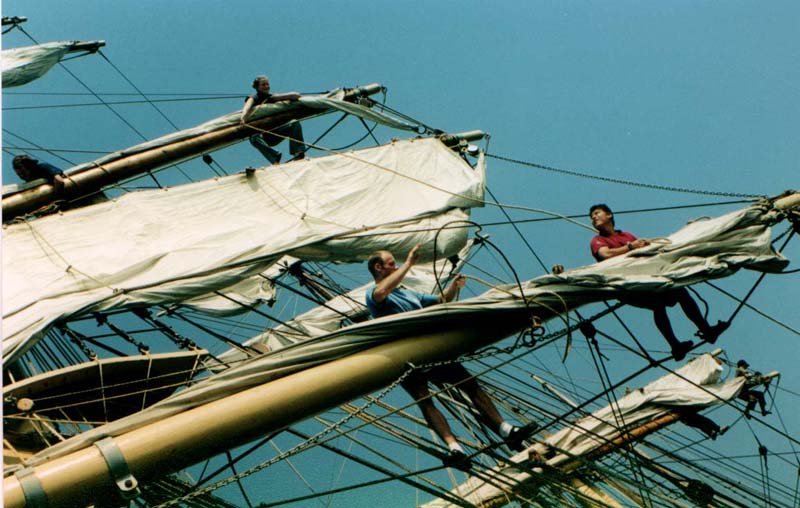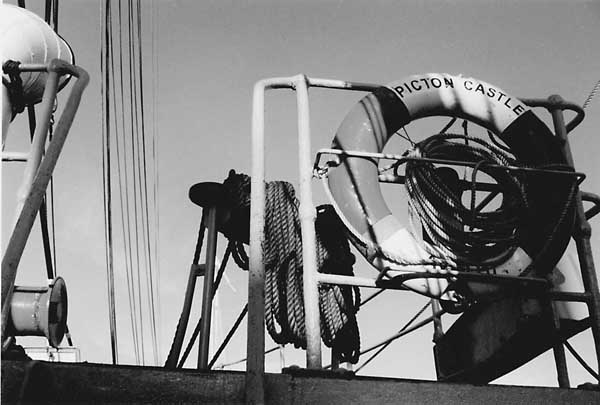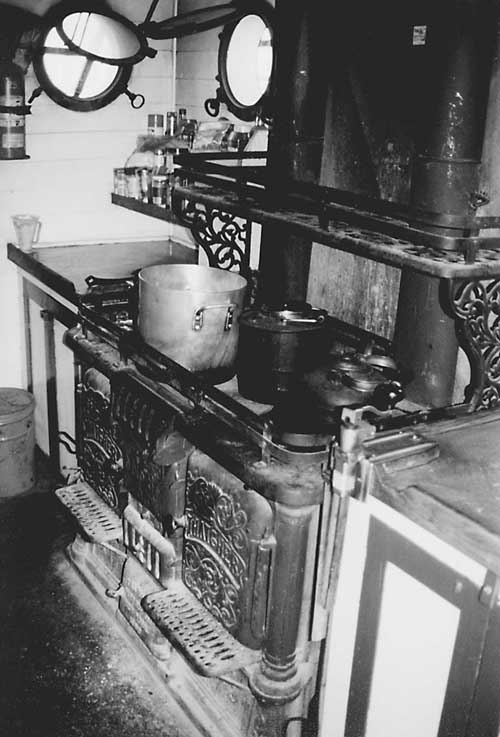
96 Hours Aboard the Tall Ship "Picton Castle"
by Paul A. Stermer
 |
| Setting the sails - 10 stories above the water - outside of South Haven, Michigan. |
From Odysseus to Ishmael, from the H.M.S. Titanic to the S.S. Minnow, images of life at sea have facinated man for ages. The stereotypical pirate has become an icon, selling everything from fast food to rum, and every seaside (and lakeside) town seems awash in maritime memorabilia for tourists: lighthouse tinkets, decorative ship's wheels, and books and videotapes of daring rescue and horrible tragedy on the high seas.
As a result, it's not easy to get past the popular myth to find out the truth about sailing ships and the open water. Spending five days aboard the tall ship Picton Castle as it sailed from Sarnia, Ontario to South Haven, helped this writer separate fact from the fiction.
"Tall ship" is a generic phrase that typically refers to large, traditional sailing vessels, especially those that are square-rigged. The Picton Castle is a "barque," the official designation for a ship with three or more masts, all square-rigged except the aftermast.
With an overall length of 180 feet (including the jib boom), 12,450 square feet of sail, three tree-sized masts and miles of rigging, the Picton Castle cuts an impressive figure whether in the open water or at the dock. The ship was converted to a sailing ship to be used for sail training during a $2 million project in 1997 at Lunenburg, Nova Scotia. It is registered in both the Cook Islands, headquarters for her South Pacific voyages, and Nova Scotia.
The most lasting impression of this journey is that keeping a ship in 'ship shape" is a lot of work - backbreaking, dirty, unglamorous work. Crew members are constantly swabbing decks, cleaning the head, scubbing dishes in the scullery, tarring the lines, mending the sails, and scraping and painting the masts.
Whether the ship is sailing or anchored, she is under constant watch. Crew members take their turns at the helm, on forward lookout or on radio watch. Coffee goes down easy and often, and sleep comes when you can get it.
Aboard the Picton Castle, shoes are useless, showers are rare; tar and soot coat nearly everything, and white clothes quickly turn gray. Deep cuts, huge bruises and thousands of rope slivers are commonplace.
It would be easy to lament this difficult way of life, but the hardy crew endures it all without a single complaint.
 |
| Her life ring on the foredeck. |
Even the ship itself seems tougher than most. The Picton Castle, built in England in 1928, served as a minesweeper in the British royal Navy in World War II. One mine actually detonated directly beneath the ship, lifting her 300-ton hull completely out of the water. Increadibly, the Picton Castle sustained no damage.
Much of the work takes as much skill as it does sweat. The ship has 175 lines, and crew members must know immediately which line controls which sail. Mending the sails and lines takes a deft hand, lots of patience, and a confusing array of old-fashioned tools, including marlinspikes, fids, serving mallets and sheath knives.
The crew works both as individuals and as part of a team - many tasks are impossible to do alone - and each member is fiercly loyal to one another. When Brian Johnston felt chest pains while the ship was docked in Sarnia, the younger crew members insisted that he visit a hospital. "The business world would benefit greatly from a ship's work ethic," said Johnston. "There is no better team-building exercise than being part of a crew."
Downtime is rare - crew members spend most of their hours working, sleeping or eating. When it does come, deckhands hold bowline (knotting) competitions below deck, everybody seems to keep a daily journal, and crew members crack jokes, share tall tales and sing old sea shanties.
 |
| Singing sea-going songs during a rare break from work. |
Because both the Picton Castle and many of her crew call Nova Scotia home, one of the favorite songs on board was the haunting, sad "Barrett's Privateers," by Stan Rogers:
"We'd cruise the seas for American Gold
We'd fire no guns, shed no tears
Now I'm a broken man on a Halifax pier
The last of Barrett's privateers."
Of course, this is the 21st century, so crew members followed up the traditional songs with a rousing version of the theme from "The Brady Bunch," shanty-style.
The ship's captain, Daniel Moreland, has been sailing for 25 years but is hardly one of the crusty old salts from sea-going literature. Moreland does cut an impressive figure as he stands on the quarterdeck giving commands, but he is by nature a quiet, well-read man who leads by example.
When the Picton Castle is under full sail, it's easy to imagine that the clock has turned back 200 or so years to the heyday of sailing ships.
Besides the diesel engine and electronic navigation equipment (standard on any ship today), the Picton Castle has very few modern conveniences. It even seems the captain and crew enjoy a sort of perverse delight in doing as much as possible "the hard way."
 |
| The ship's antique cast-iron, coal-burning stove. |
Every meal is cooked from scratch, by hand, on a 107-year-old cast-iron stove. The first mate charts the ship's course by hand using sextants, a chronometer and world charts. And no dainty automatic hydraulic system will heave up this ship's anchor - that torturous task takes a couple dozen people 20 to 30 minutes using the hand-cranked windlass.
To date, the Picton Castle has visited some of the most beautiful, remote areas of the world, including Bora Bora, Tahiti, Bali, the Seychelles, Galapagos, and Pitcairn Island, home of the actual descendants of Fletcher Christian and the other mutinous crew members of the H.M.S. Bounty. In November, the ship begins another 18-month voyage that will follow the trade winds around the world.
Once upon a time, ship's crews were either young boys who joined as apprentices or rowdy men who probably couldn't get work anywhere else. "19th-century psouters signed on any restless spirit who was tired of farming or millwork, as well as adventurers, drunkards, escaped criminals, town misfits and runaways," said C. Keith Wilbur in "Tall Ships of the World."
Today, the sailor's fraternity has become decidedly co-ed. Aboard the Picton Castle, Julie Gagne of Quebec is the bosun, and both able-bodied seamen are women: Lauran Lawson, 19, of South Africa, and Maria LaPointe, 20, of Prince Edward Island. In fact, nearly half the Sarnia-to-South Haven crew was female. "On a sailing ship, success depends on what you know, not how strong you are," said crew member Haley Pepper.
No longer are crew members all young, either. Milena Tvrdon is a 54-year-old mother and grandmother from Sarnia who quit her job and left home to pursue her dream of becoming a real sailor. Lorenzo Caricchio, 56, from Bloomfield Hills, Michigan, would simply rather be in a sailing vessel than anywhere else. He sails nearly all year in Lake St. Clair, slowed only by Michigan's most bitter winter weather.
During the Great Lakes voyage, a number of creepy happenings helped support the idea that sailing can be a mysterious adventure. For two nights in a row, bats inexplicably appeared on board the Picton Castle, weaving silently through the main deck before flying back to land. One morning, the ship ran into a fog bank the hung in sheets, creating little rainbows - and a false horizon. And late one night, as the ship was anchored in a cove at Bois Blanc Island (near Mackinac Island), the waters of Lake Huron carried the sounds of a far-off ship right up to her deck, making it sound as if that ship were inches away.
Certainly, the open water has a hypnotic attraction that's unlike anything dry land can offer. It becomes possible - even natural - to stand on deck for hours at a time, watching the bow break the deep blue-green water and send crest after foamy crest rippling endlessly away. At night, the sight of the ghostly silhouette of the masts against a star-swirled sky can fill even the most cynical person with awe and inspiration. Johnston, one of the ship's elder statesmen, believes that no sailor can be an atheist. "There must be an engineer for all this," he said, gazing at the heavens. "It can't be a mistake."
Still, the question that has haunted sailors and poets for centuries remains unanswered: Why do people in today's world - where sailing has become a choice, not a necessity - willingly risk their safety, privacy, freedom and sanity to go to sea? "I am tormented with an everlasting itch for things remote. I love to sail forbidden seas, and land on barbarous coasts," says Ishmael in Herman Melville's Moby-Dick.
The Picton Castle sail training manual sheds more light on the eternal question. "A number of our graduates intend to go on to service within the tall ship realm," it says. "Others want to strengthen their seamanship skills because of personal plans that call for boat ownership. Still others come forward seeking a deeper understanding of time, place and self."
Johnston put it another way. "All sailors have a little insanity, a little eccentricity, and an extra chromosome that compels them to sail," he said.
It's not a question of why a person sails, but simply when.
Paul A. Stermer is a freelance writer from St. Joseph, MI.